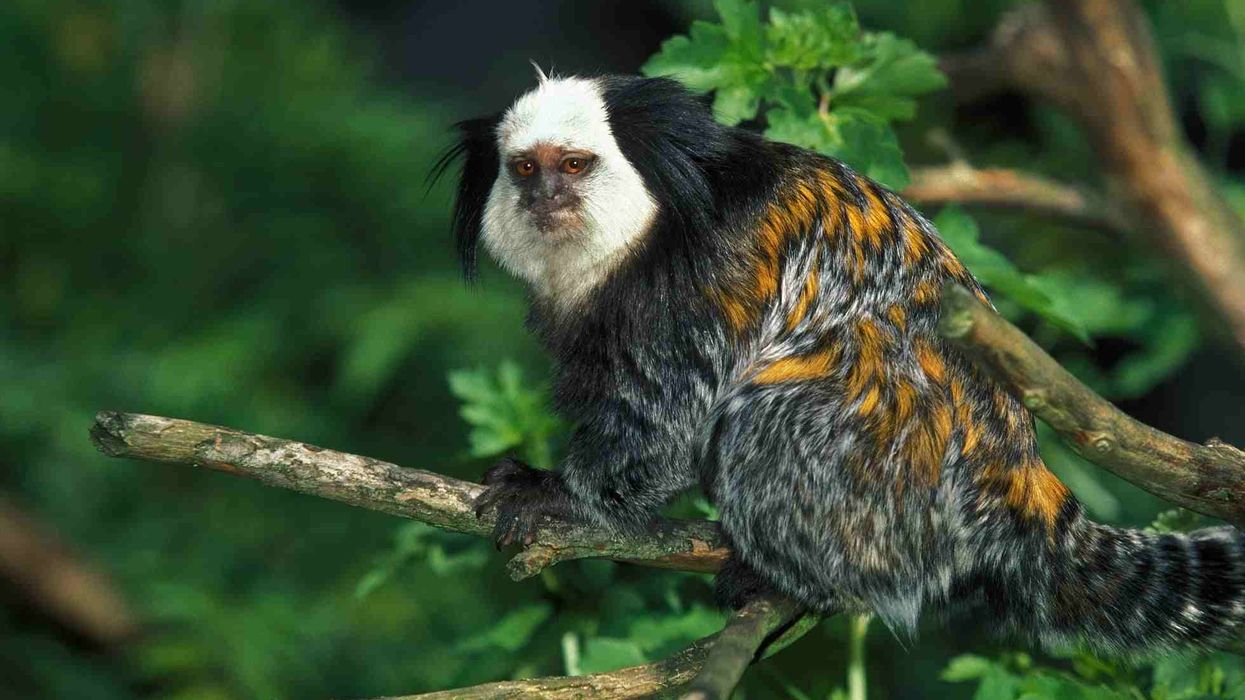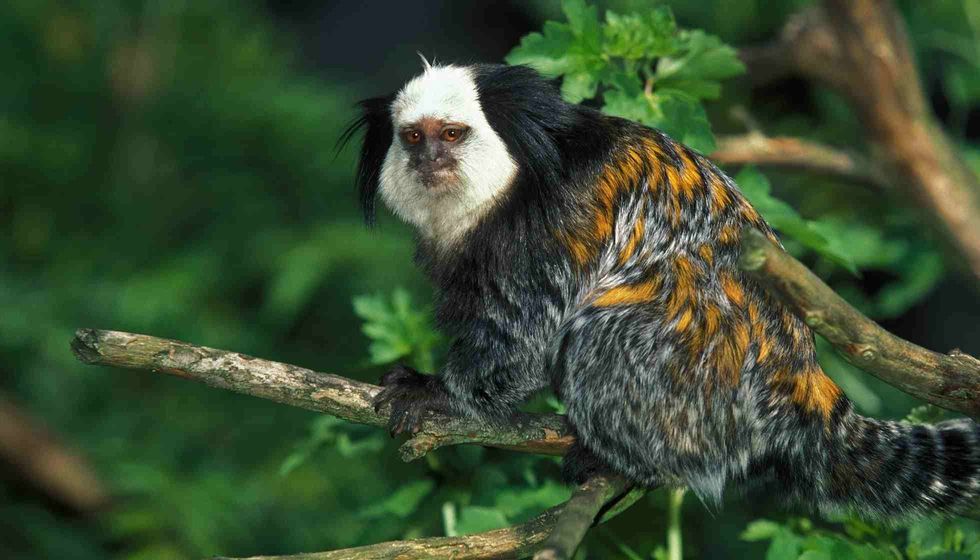Marmosets are new world monkeys under the class Mammalia, order Primates, family Callitrichidae, and genus Callithrix. They include 22 species and are mostly found in the forests of South America and Central America.
Marmosets survive on a mostly herbivorous diet of tree gum, sap, leaves, and some fruit. They also use their teeth to cut holes in tree trunks and harvest sap.
They are sometimes confused with Tamarins, another species of New World monkey, despite differences in the shape of their jaw. But marmosets are distinguished by their long and sharp (lower) incisors, fan-shaped ear tufts, sharp claws, and long tail.
They are active, friendly creatures and can be easily domesticated. In fact, they are frequently kept as pets in their native home range. But maintaining their diet and habitat can be a challenge outside their home range. Today, these animals are often used in labs for testing, as their body mimics many characteristic traits of the human body.
Go ahead to read more information on marmosets, whether it be the pygmy marmoset or common marmoset. At Kidadl, you can explore several other fascinating forms of New World monkeys, including squirrel monkeys and Indri.
Marmoset Interesting Facts
What type of animal is a marmoset?
A marmoset is a primate monkey-like animal, belonging to the class Mammalia and order primates. There are 22 species of marmosets classified as New World monkeys under the genus Callithrix. Within species, they have different nicknames. For example, the common marmoset is also called a white-tufted-ear marmoset.
What class of animal does a marmoset belong to?
A common marmoset belongs to the mammal class in animals.
How many marmosets are there in the world?
The total count of marmosets in the world is not clear. But this primate has seen a significant reduction in its population (20-25%) in the past two decades.
Primary threats include habitat loss, snakes, and raptors. Popular species like the common marmoset and pygmy marmoset are estimated to have healthy population numbers. There are also some species of marmosets that are Critically Endangered (like the buffy-headed marmoset).
Where does a marmoset live?
Marmosets live in a tropical rainforest. They are mostly found in the forests of South America.
What is a marmoset's habitat?
Marmosets live high up in the trees and prefer a forest habitat. They are mostly found in South America (Brazil, Peru, Columbia, Bolivia, Ecuador, Paraguay) and in some parts of Central America (Mexico). They survive on a diet of tree sap, tree gum, leaves, some fruit, and the occasional insects.
Marmosets also have claws (not nails) and use their long tail when they want to hold and balance. In fact, their tails help them swing gracefully between trees despite their small size.
They are diurnal animals and highly active during the day in their natural habitat. They are protected from most ground-based predators in the forest but are still vulnerable to snakes and raptors.
Who do marmosets live with?
Marmosets live high up in trees in groups of 3-15, also called a family. Each group will have at least one female and many males. Also, members of groups may be related (like sexual partners and their offspring).
Marmosets forage for food with their groups. Each group has its own territory. Marmosets are moderately territorial and can get mildly aggressive with strangers. But territories do tend to overlap, so this behavior is not consistent.
While they are traditionally wary of strangers (especially in the wild), they may still be greedy enough to reach out for a banana in your hand without your permission. They can also bite when they feel threatened. However, these primates can be domesticated and are frequently kept as pets.
How long does a marmoset live?
A marmoset can live between 5-15 years in the wild. When they are kept as pets in a managed habitat, they can live up to 20 years.
How do they reproduce?
The body of a marmoset grows until they reach adulthood at 12 months of age. They take an additional 6-12 months to achieve sexual maturity. They are often monogamous and tend to mate within their own group.
The gestation period is six months. A female will often give birth to twins who may or may not be identical. The exception is a Goeldi's monkey (also a marmoset species), as the female only delivers triplets or a single infant during birth (not twins).
Finally, this is a species where the man contributes significantly to care for the offspring. In fact, it is the male marmoset who will forage food and protect infants after birth. Infants continue to remain in the parent group to care for future offspring until they achieve sexual maturity and find their own group.
What is their conservation status?
The conservation status of marmosets, in general, is Least Concern. But there are related species under the family Callitrichidae with varying population numbers.
Popular species like the common marmoset, Geoffroy's marmoset, and the pygmy marmoset have healthy numbers and require minimal conservation. There is also the buffy-headed marmoset which is Critically Endangered and part of IUCN's Red List.
Marmoset Fun Facts
What do marmosets look like?
A marmoset looks like a cute cross between a monkey and a squirrel. It has a small-sized body with dense yet silky hair. It varies in color based on the species, in shades of black, brown, gray, and white.
This primate also has sharp claws (as opposed to nails). The tail is long and used for balance. In some subspecies, the tail can be twice the length of the body.
There are 22 species of marmoset new world monkeys, and several of them are characterized by ear tufts. They uniformly have long and sharp lower incisors to cut holes through tree trunks and harvest the sap. In fact, marmosets are differentiated from other related squirrel monkeys (like Tamarins) based on the shape of their jaw.

How cute are they?
Marmosets are hilariously cute, with their small size and humorous antics. They can comfortably fit within the palm of a human adult.
So carrying them in your pocket is possible in theory! This is also a species that can be easily domesticated, weaning them off biting and other aggressive behavior. So they are frequently kept as pets by South American locals.
How do they communicate?
Marmosets use a combination of vocal and non-vocal signals to communicate. They also have a sophisticated structure to their calls. For instance, calls within a group are less discernable to strangers. Calls between groups are louder, and with similar sounds.
How big is a marmoset?
Marmosets are small-sized primates and are less than 8 in (20 cm) in length. With this, they are comparable to the size of a squirrel. The pygmy marmoset is the smallest while the common marmoset is the largest.
How fast can a marmoset run?
A marmoset is recorded to travel at a speed of 1.4 mph (2.3 kph). But some species of New World monkeys can be very quick, running at a speed of 22 mph (35 kph).
How much does a marmoset weigh?
The weight of marmosets varies slightly based on the species and falls in the range of 3.5–21 oz (100–600 g).
What are the male and female names of the species?
Both sexes in this species are simply called marmosets. Also, they exhibit mild sexual dimorphism as males tend to be larger.
What would you call a baby marmoset?
A baby marmoset is called an infant.
What do they eat?
Marmosets usually feed on a herbivorous diet of tree sap, tree gum, leaves, and some fruit. In fact, the lower incisors of a marmoset animal are noted for being long and sharp.
These primates are hence able to dig deep into tree trunks with their teeth and harvest the sap. In some cases, these new world monkeys may also include insects as part of their diet.
Marmosets live high up in the trees and are protected from most ground-based predators. But these small-sized primates are still vulnerable to snakes and raptors. One of their main predators in South American forests is the harpy eagle.
Are they loud?
Marmosets vary the loudness of their calls depending on the distance from their group. If a marmoset is communicating within the group, the call is low. Conversely, marmosets get louder when communicating between distant groups.
Would they make a good pet?
Marmosets are often kept as pets by South American locals. But caring for them outside their natural habitat can be a challenge. Marmosets are exorbitantly expensive pets to buy, and an infant marmoset can fetch upwards of $3,000 USD! However, there is an active campaign in the UK to ban all primates due to their unpredictable behavior.
Did you know...
Marmosets are the only primate species where a female can deliver non-identical twins at birth.
Are marmoset monkeys aggressive?
Marmosets are generally friendly within their group. They can also welcome known human presence and contact. But these primate animals may get mildly aggressive with males outside their group’s territory. They may also resort to biting (humans) when they feel threatened.
Is a marmoset a monkey?
A marmoset is classified as a New World monkey. Here are some critical differences between traditional (Old World) monkeys and New World monkeys:
Traditional monkeys descend from apes and belong to the family Cercopithecidae. New World monkeys also have Simian genes (along with apes).
Traditional monkeys have narrow noses. Marmosets and Tamarins have wide and flat noses.
Traditional monkeys have a face that is directed downwards. On the other hand, the face of a marmoset is directed sideward.
In traditional monkeys, infant care is independently managed by the female. In contrast, male marmosets play an active role in infant care.
Here at Kidadl, we have carefully created lots of interesting family-friendly animal facts for everyone to discover! Learn more about some other mammals from our Schnoodle facts and addax facts pages.
You can occupy yourself at home by coloring in our free printable marmoset coloring pages.










